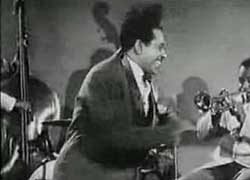 The Snader telescription Calloway Boogie aka Cab's Club (1950) starts right off with Cab Calloway dancing up a storm. A scaled down version of his band is seated behind him: Panama Francis on drum kit, Milt Hinton on doublebase, Jonah Jones on trumpet, Dave Rivera on piano. For this number, Jonah on trumpet is mightily highlighted.
The Snader telescription Calloway Boogie aka Cab's Club (1950) starts right off with Cab Calloway dancing up a storm. A scaled down version of his band is seated behind him: Panama Francis on drum kit, Milt Hinton on doublebase, Jonah Jones on trumpet, Dave Rivera on piano. For this number, Jonah on trumpet is mightily highlighted.
It's a one-take live performance & Cab's not perfectly miked, but it has that "no retakes" realism to it that is a pleasure.
The song however boils down to a fairly standard boogie woogie, with new words put to an old riff: "Here's a little song I'd like to do for you/ Ain't nothin' to it, it's easy to do/ Called the Calloway boogie. Calloway boogie/ Keeps you groovy twenty-four hours day."
It's really Jonah's trumpet that saves the song from being a cookie-cutter number to the standard boogie beat. This song's studio recording includes Cab's entire band, & this scaled down version is actually a very lovely alternate, thanks to Cab's major sideman Jonah Jones who just can't be praised enough.
Less than halfway through, a dancer comes running out, I think she's a member of the Calloway family but her identification as his daughter Chris is incorrect as she's much too old. Through the instrumental she & Cab do a boogie woogie together.
The Snaders usually had more than one camera going, so we are also treated to some close-ups of Cab, the dancer, & most delightfully, each member of the band as they perform. This was apparently something Cab insisted on -- he was a great one for sharing the spotlight -- as the soundies he made in 1942 also give cameo close-ups to bandmates, & this was by no means true for most bands who performed in Snaders & Soundies.
Cab dances himself into a steaming sweat then finishes off the last vocal verse without seeming to need a breath.
This three-minute telescription was collected into a dvd set distributed as Swingtime Collection Volume 15; aka, Swingtime Video 3 (1985), fifty-two minutes held together by the theme "small bands," ranging from the awful (The Four Freshmen) to the sublime (Count Basie Sextet).
This compilation includes all of Cab's 1950 telescriptions which come off as a mini-concert. Calloway Boogie followed by the rest of the 1950 & '51 Snaders of I Can't Give You Anything But Love, Minnie the Moocher, One for My Baby & St. James Infirmary. The same group of Snaders for Calloway & Basie can be found in the same order on The Swingtime Collection Volume 15 (1985).
Or Cab's Snaders together with some of his earlier Soundies & film clips can also be had on the dvd compilation Swing Era: Cab Calloway: Hi-De-Ho & Other Movies (2004).
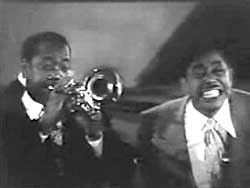 Jonah Jones sings I Can't Give You Anything but Love (1951) while Cab Calloway dances to the scaled-down band, Cab's quartet with Dave Rivera on piano, Milt Hinton on double bass, Jonah with his trumpet.
Jonah Jones sings I Can't Give You Anything but Love (1951) while Cab Calloway dances to the scaled-down band, Cab's quartet with Dave Rivera on piano, Milt Hinton on double bass, Jonah with his trumpet.
This Snader telescription was recycled into a half-hour program originally for television, Showtime at the Apollo: Jazz Time (1955), one of a series of half-hour programs originally for television, each pretending to be an Apollo Theater event.
They were in reality shows cobbled together from telescriptons of Ruth Brown, the Delta Rhythm Boys, & others, with just a little new footage added with Willie Bryant as emcee, interacting with his comedian friends Nipsy Russell & Mantan Moreland.
Cab never sings in I Can't Give you Anything but Love, but he does exaggeratedly pretend to be scatting the sounds that come from Jonah's trumpet.
Completing the lyrics, Jonah goes right into an extended trumpet solo. This is so good it's amazing, & it's hard to imagine an entertainer who wouldn't leave you disappointed that Cab wasn't doing the singing.
His singing compared to Cab's was not flashy. He sings in a subdued yet magically intense manner. The trumpet has more overt flash.
Jonah "Eggy" Jones, an orphan from Kentucky, was simply a super, super talent, who many have said was second only to Louis Armstrong in greatness. Having already made a name for himself with Stuff Smith's Onyx Club Band during the late '30s, he joined Cab's orchestra in 1941 & remained with him for eleven years.
Later in the 1950s he developed a toned down melodic "pop" sound that gave him enormous cross-over cache from the jazz world to pop trumpeteer, received a Grammy in 1959, & led his own quartet for many years.
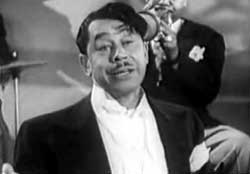 For One For My Baby (1951), some tables, a tablecloth & chairs were dragged out on the sound stage to give a slight illusion of it being a cafe. Silhouettes of "after closing" upside-down chair-legs have large shadows on the backdrop, a little arty, especially for a Snader telescription which were often quite plain looking.
For One For My Baby (1951), some tables, a tablecloth & chairs were dragged out on the sound stage to give a slight illusion of it being a cafe. Silhouettes of "after closing" upside-down chair-legs have large shadows on the backdrop, a little arty, especially for a Snader telescription which were often quite plain looking.
As the number begins, Cab's seated alone at a table. Jonah Jones is seated further back in the "room" with his trumpet shouldered. As it's closing time, the cook or owner or bartender, a pal of Cab's at any rate, comes out with a beer, & sits opposite him. The song identifies him as Joe. Cab begins to sing the blues with soft tragic sincerity:
"It's a quarter to three/ There's no one in the place except you & me/ So set 'em up Joe/ I'm got a little story you ought to know/ We're drinking my friend/ To the end of a brief episode/ Make it one for my baby, & one for the road."
In the environment provided, Cab is really acting & bringing the song's sad sentment alive. , He brings none of his usual hep-cat up-beat joyfulness to the number, but is truly singing the blues.
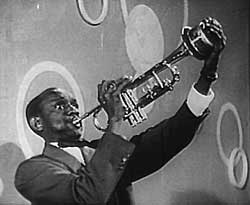 The Minoco Production soundie Minnie the Moocher (1942) is one of several filmed versions of this popular song. He was first filmed singing it in 1932 as part of a Betty Boop cartoon, & last filmed singing it in The Blues Brothers (1980), & it just never got old. The Minoco Production soundie Minnie the Moocher (1942) is one of several filmed versions of this popular song. He was first filmed singing it in 1932 as part of a Betty Boop cartoon, & last filmed singing it in The Blues Brothers (1980), & it just never got old.
The 1942 soundie is a distinct version, starting off with a marvelous trumpet solo by Shad Collins, who'll be highlighted on all of Cab's 1942 Minoco soundies.
When Cab starts singing, he's standing beside the piano, so we get a lovely portrait of Benny Payne. Throughout the number there will be great portraits of individual band members.
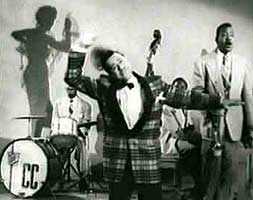 The Snader telescription version of Minnie the Moocher (1950) stands out as the one that has a silhouette of Minnie on the backdrop. The Snader telescription version of Minnie the Moocher (1950) stands out as the one that has a silhouette of Minnie on the backdrop.
It got recycled into the faked Apollo Theater concert film Rhythm & Blues Review (1955), & retained in the half-hour version Showtime at the Apollo: Variety Time (1955). The short version includes telescription films of Big Joe Turner, Ruth Brown, Lionel Hampton & Sarah Vaughn.
Cab's wearing a checked jacket & loping back & forth in front of his small band. Jonah Jones with trumpet muted is in the medium-background, helping make this a great performance.
Snaders were genuinely live performances, so sometimes had a little oomph if an artist was feeling his oats on a given day or number. For this one, Cab had oomph.
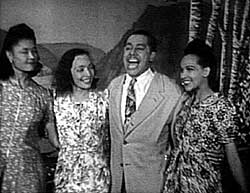 Another Minoco soundie is Virginia, Georgia & Caroline (1942), which continues the almost unique intent of showing each of the performers in close-up. Another Minoco soundie is Virginia, Georgia & Caroline (1942), which continues the almost unique intent of showing each of the performers in close-up.
I like to believe Cab himself insisted on this approach, as he possessed such explosive charisma, he didn't need to hog the spotlight to remain a powerhouse in any performance. And he appreciated his musicians who provided an unusual degree of give & take.
The lyrics run in part: "Lovely sisters of the south/ If they're not sweet then hush my mouth/ I'm mighty happy they're friends of mine/ Virginia, Georgia, & Caroline."
The song obviously celebrates the southern states, & speaks of friendship & beauty rather than romance. But at the same time it plays with the names as Cab's actual girlfriends, & three lovely lasses play just those roles in this soundie.
I'm not a grea fan of the so-called "Cabaliers" whoa re the Four Palmer Brothers who performed a great deal with cab in the 1940s. Cab obviously loved them, but they were just not jazzy guys.
Their presence this time is restricted to background "da-dat-dat-tahs" harmonized like they wanted to be the Andrew Sisters. So they don't afflict the song, which is a charming number, less flashy than a lot of Cab's better known tunes, but a solid good piece. And for bonus there's a trumpet solo by Shad Collins & trumbone solo by Tyree Glenn.
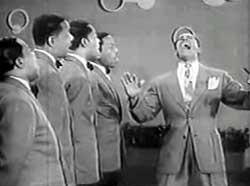 Blues in the Night (1942) with just a tiny lead-in from the Cab Calloway Orchestra quickly has Cab beginning the song: Blues in the Night (1942) with just a tiny lead-in from the Cab Calloway Orchestra quickly has Cab beginning the song:
"My momma done told me/ When I was in knee pants/ My momma done told me, son" ("What did she tell you?" the four Palmer Brothers interject), "A woman does sweet talk/ And give you the glad eye/ But when that sweet talk is done/ A woman's a two-face/ A worrisome thing that will leave you to sing the blues/ In the night."
A spectacular lyric by Johnny Mercer & great blues tune by Harold Arland, means the unexpected tepidity of Cab's performance is certainly not the song's fault.
Cab can't help but have loads of personality but he's totally subdued on this number so as not to show up the bland Palmer brothers (i.e., "the Cabaliers"). They harmonize without much charm or strenth & Cab's probably trying not to eradicate their existence with the enormity of his talent.
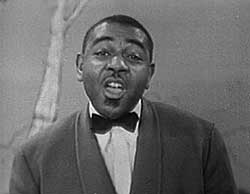 The Four Palmer Brothers, again billed as the Cabaliers, do their least stinky work on the slight but amusing The Skunk Song (1942). The Four Palmer Brothers, again billed as the Cabaliers, do their least stinky work on the slight but amusing The Skunk Song (1942).
It also got recycled into the "home movie" market with two other soundies (Rocco Blues by Maurice Rocco & Got a Penny, Benny by the Nat King Cole Trio, & given the overall title Sepian Swing (1946).
The Palmers start off the goofy number: "The little red fox & the three little pigs were really famous fellas/ Yeah all our friends are successful now, it's no wonder that we're jealous/ Oh, nobody loves us/ We hang down our heads in shame/ Nobody loves us/ We're all so nice & tame."
It's generous of Cab to give his back-up singers this chance to shine, but fact is, the song doesn't come alive until Tryee Glenn steps out of the bandstand to the front & sings a verse with a lot more verve & humor for what is essentially a comic number, though the Palmers just fail to convey that.
Once again we have as bonus a trumpet solo by Shad Collins, who was on a rule the day these Minoco soundies which were made all back to back.
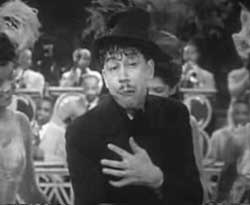 Mostly Cab restricts himself to conducting, a little bouncy-dancin', & mugging, but then at last he does sing the finale. It's weird to think, but Tryee was so good, Cab's addition wasn't even needed, though it was nice. Mostly Cab restricts himself to conducting, a little bouncy-dancin', & mugging, but then at last he does sing the finale. It's weird to think, but Tryee was so good, Cab's addition wasn't even needed, though it was nice.
Wearing a tattered top hat for the blues standard Blow Top Blues (1945), Cab's standing in front of his orchestra, singing about losing his mind & being sent off to Bellevue hospital.
Cab turns in a fine rendition, not too much distracted by the babes he weaves & dances amidst:
"I got bad news baby/ And you're the first to know/ "I got bad news baby/ And you're the first to know/ I discovered this morning that my top is about to go."
"Blow Top Blues" was written by Leonard Feather, better remembered as a jazz critic & historian than composer.
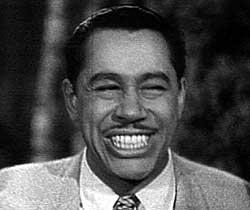 The four Minoco soundies are included in the compilation dvd Cab Calloway: Swinging at His Best (2005). It's a somewhat random selection of film clips & soundies, with no identifiers for sources, & no extras. The four Minoco soundies are included in the compilation dvd Cab Calloway: Swinging at His Best (2005). It's a somewhat random selection of film clips & soundies, with no identifiers for sources, & no extras.
I recognized most of the sources. Two numbers are from Manhattan Merry-Go-Round (1937) & several from Hi-De-Ho (1947), both of which would be better seen in their entirety; these make up the bulk of the collection of fifteen numbers. The "song selection" menu lists a sixteenth piece called "Cab's Delight," but Cab recorded nothing so named.
"Cab's Delight" is actually the Britt Orchestra paying homage as images of from Cab's soundies & clips flash by, finally moving into the closing credits for the entire compilation. It's really not that good & odd that with nothing else original to this "just the clips, ma'am" compilation they'd bother to promote the Britt Orchestra instead of using some piece of Cab's music behind the credits.
The entire selection of clips & soundies amounts to a scant forty-five minutes, kind of a rook, as there were additional soundies & telescriptions that might've been included, before resorting to mere clips. The compiler could have included much more without added cost since it's public domain material, including Cab's earliest short subject musical films from the 1930s.
It comes close to being the same selection as in Jazz Classics: Cab Calloway & His Orchestra (1987), dashed together by a company called Videofidelity, though the overlap isn't complete, three items being missing from the newer compilation, namely a truncated "Call of the Jitterbug," plus "Hot-cha Razz-ma-tazz" & "Long About Midnight" all from Cab Calloway's Jitterbug Party (1935) which is short enough in its entirety that it should've been included intact rather than triple-excerpted.
copyright © by Paghat the Ratgirl
|
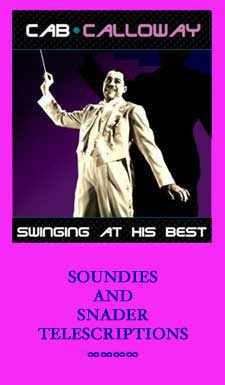




 The Snader telescription version of Minnie the Moocher (1950) stands out as the one that has a silhouette of Minnie on the backdrop.
The Snader telescription version of Minnie the Moocher (1950) stands out as the one that has a silhouette of Minnie on the backdrop.


 Mostly Cab restricts himself to conducting, a little bouncy-dancin', & mugging, but then at last he does sing the finale. It's weird to think, but Tryee was so good, Cab's addition wasn't even needed, though it was nice.
Mostly Cab restricts himself to conducting, a little bouncy-dancin', & mugging, but then at last he does sing the finale. It's weird to think, but Tryee was so good, Cab's addition wasn't even needed, though it was nice.